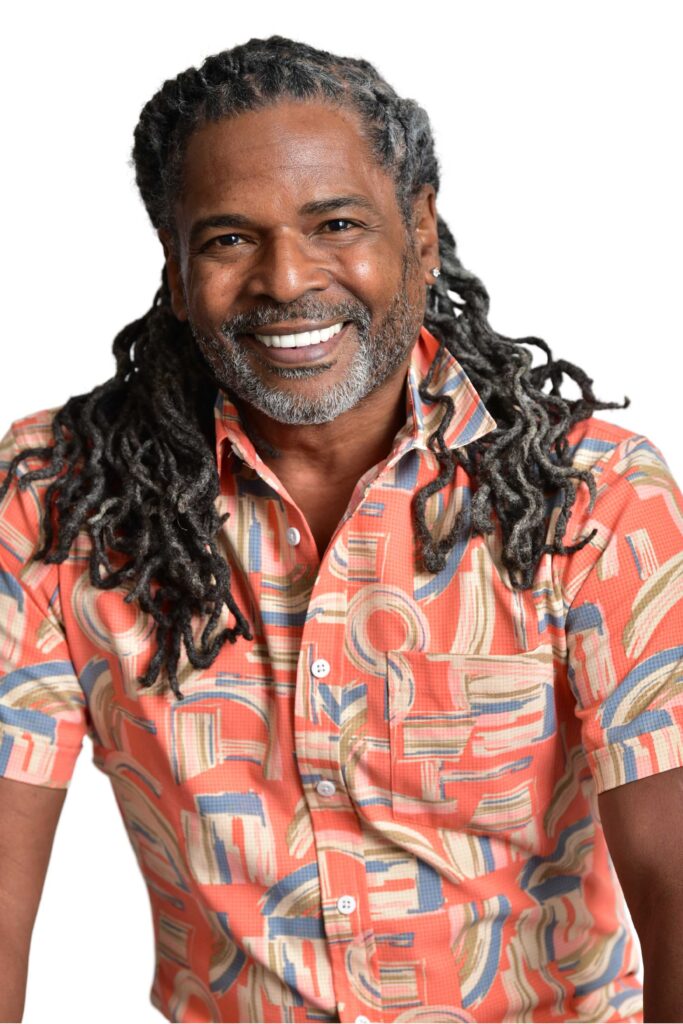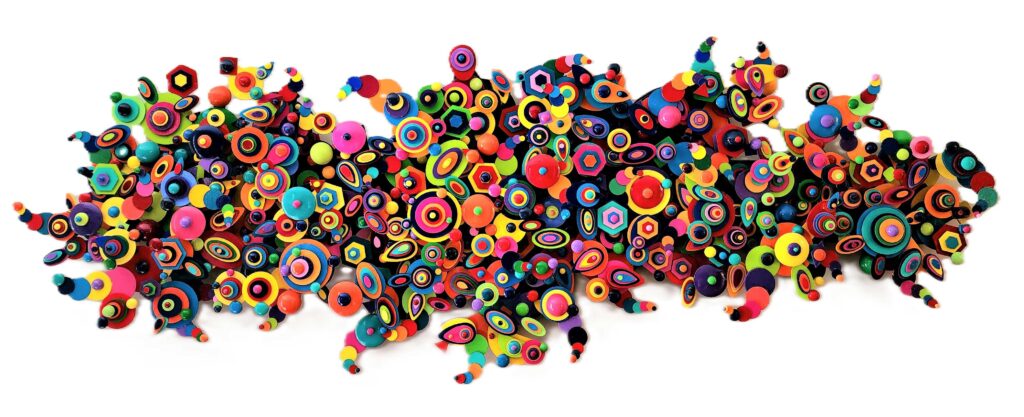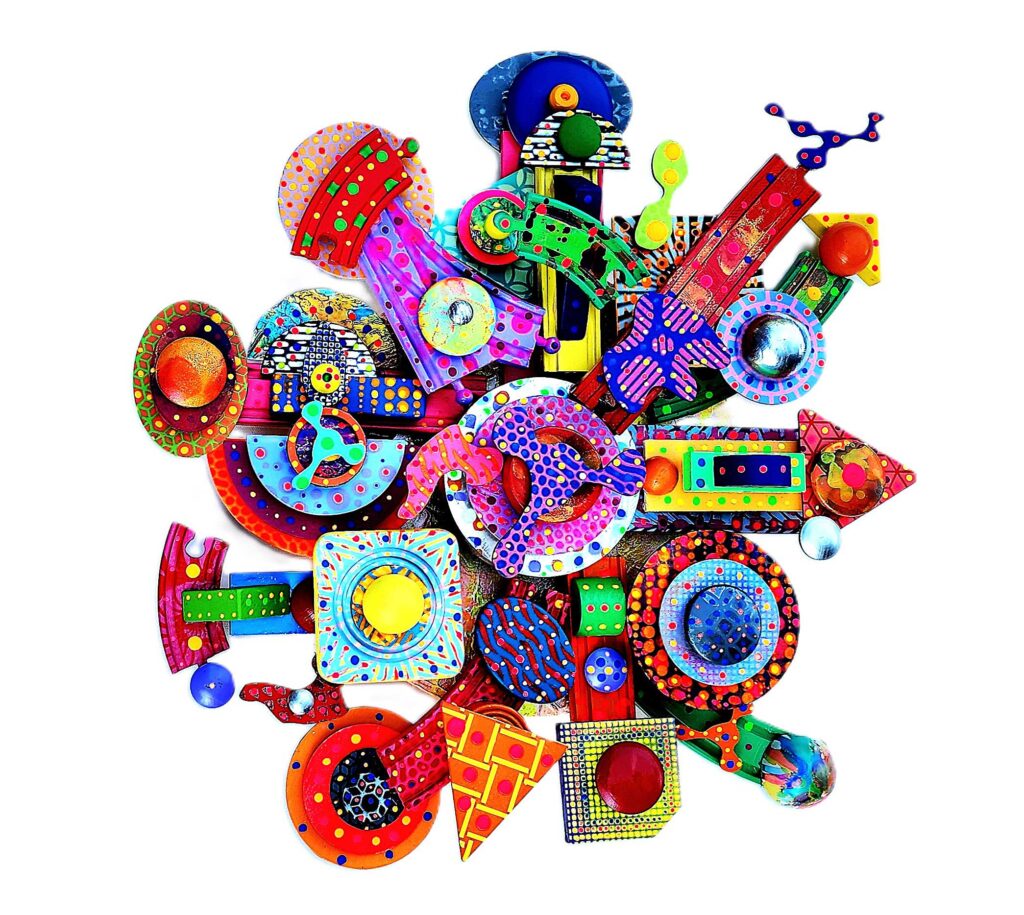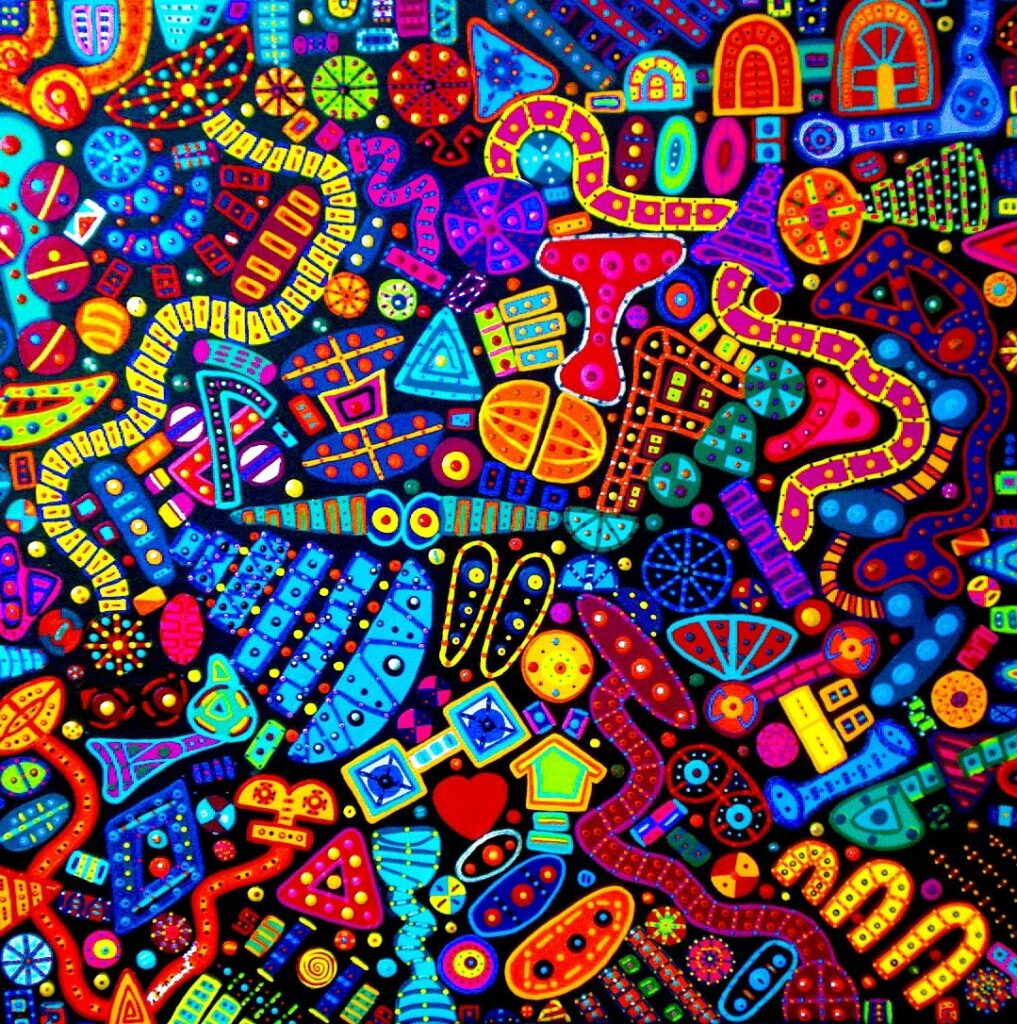Interview with Reginald Laurent


Reginald Laurent, Orchestrated Funk, 2024, Wood Assemblage
Born in Chicago, Reginald Anthony Laurent is widely noted for being a “master colorist.” He is proficient in several mediums and techniques, but he is mostly known for painting colorful, multi-media abstracts. The self-taught, award-winning artist successfully managed a dual career in corporate America while cultivating his career as an artist. Laurent is noted for his dynamic use of bright colors, which are mostly comprised of energy-laden organic and geometric shapes representative of his urban upbringing.
Conversely, his colorful yet “quiet” palette knife renderings are based on his keen observations of the beauty of nature in Georgia. Teachers across the country utilize Laurent’s DNA Series as a study with their own students, and he has received stellar accolades from educators for the Zoom sessions he offers to schools across the country and internationally. As a result, his art has motivated a wide range of students in every corner of the United States and beyond. Laurent says while art is clearly his passion, his purpose is to motivate children to create.
As a boy growing up on the Southside of Chicago, Laurent was a “compulsive doodler”—constantly drawing and sketching in the margins of his notebooks whenever he was in a class. The same geometric and organic shapes he randomly sketched as a child are still evident in his works today. Laurent says this style is his “Artistic DNA” and has always been a part of his creative composition.
The foundation for his vast palette of colors is based on memories from when he saw his first Mardi Gras as a child living in New Orleans and as an adult when he moved to Atlanta from Chicago and saw his first real “Fall”. Laurent developed his style over more than 30 years and his colorful creations are in many public, corporate and private collections, including those of Atlanta Mayor Andre Dickens, Michael Jordan, Shaquille O’Neal, Grant Hill, the City of Carrollton, Fulton County, City of Atlanta, and Home Depot Headquarters.
Laurent says his art reflects God’s creativity—not his own. While art is clearly his passion, he humbly describes himself as one of the vessels God uses to inspire and motivate children to create art.
 Reginald Laurent, The Art of Diversity, 2022, Wood Assemblage
Reginald Laurent, The Art of Diversity, 2022, Wood Assemblage
My art represents the diversity and inclusion of every culture—the backbone of what makes the world such an interesting, complex, and beautiful place to inhabit. The same is true for my canvas, for it is the only place I know where I can mix, mingle, and integrate beautiful pigments and hues of colors. Each color has its own space and purpose. Each color complements, enhances, and respects the others.
My mission is to help color accomplish on canvas what humankind can’t seem to accomplish on earth: living harmoniously. At the end of the day, whether I use a palette knife, wooden shapes, or my DNA Series style, the objective is always the same: to use every color in the world to reflect humanity and to draw the viewer into a space that reflects their own.
Read our interview below to get a glimpse into Reginald Laurent’s creative journey.
You often use symbolism in your work to convey deeper meanings. Can you share how your personal background shapes the symbols you choose to work with?
The symbols in my work are deeply personal, originating from the doodles I created as a child. These geometric and organic shapes are integral to my artistic DNA. It’s like being fluent in a language without fully grasping its context—what comes naturally isn’t always easy to interpret.
The vibrant, organic shapes in my art symbolize people, highlighting our diverse physical forms and features. Each shape is treated as an individual, never intersecting with another, allowing it to shine on its own merit and visual characteristics. Yet, together, they form a cohesive part of a larger entity, celebrating individuality within unity.
Your use of varied wood tones and textures adds a lot of depth to your work. How do you approach the selection of materials, and do they hold specific meanings or stories for you?
I was fortunate to attend Chicago Vocational High School, a trade school where I majored in cabinet making. This experience allowed me to become intimately familiar with various wood species, their unique characteristics, and patterns. The organic features, density, and earthy smells of wood captivated me.
Although I began my artistic journey painting landscapes on canvas, I soon started using wood as a substrate. Some of my early works included pedestals with matching tables. The combination of an organic canvas, like wood, with my organic shapes felt natural and has proven to be a perfect marriage of materials.
I believe that art should be engaging, and adding depth and texture helps draw the viewer into the work as the patterns and textures intertwine. Growing up in Chicago, the city’s grit and unique architecture have become ingrained in my artistic DNA. One of my works titled Southside is made of metal and wood which captures the true essence of Chicago.
 Reginald Laurent, Rush Hour, 2024, Wood Assemblage
Reginald Laurent, Rush Hour, 2024, Wood Assemblage
Your work features a blend of organic and geometric shapes. How do you strike the balance between these contrasting forms in your creative process, and what do they represent for you artistically?
I approach the incorporation of shapes in my work from a societal perspective. I believe that if we are fortunate enough to share this earth at this exact time, then we all belong. My objective is to take shapes that might seem incongruent and allow them to coexist harmoniously in my abstract renderings.
I grew up in Chicago, which is still one of the most segregated cities in America. Many of my narratives have a foundation based on my experiences growing up in these circumstances. Segregation can limit exposure to different cultures and perspectives, reducing opportunities for cultural exchange and understanding. As I fill the negative space of my substrate with shapes, it becomes clear to me what type of shape is needed to complete the “community” I am creating. It is the collective abstractness, shapes and colors that make my works a harmonious success.
The finished piece achieves a balance where no single shape, form, or color is more important than another. These shapes symbolize people and their wonderful inherent and cultural differences. I truly believe this diversity is what makes the world, and specifically communities, so unique.
Assemblage is a key part of your artistic process. What draws you to this method of creation, and how does it help you express ideas that other forms of art might not?
I began creating wood assemblages in 2020, during the height of the pandemic. My solo exhibit, “From the Southside to the South,” was scheduled to open on March 30th, but was unfortunately canceled. After working on a body of work for two years, it felt like all my efforts were in vain. In an artistic funk, I decided to experiment with some random wood pieces I had purchased earlier, intending to eventually create “something.”
What emerged were flat wooden assemblages that I abstracted. It didn’t take long for me to elevate them to a 3D level, integrating my love for woodworking into the process. Working with wood felt natural, allowing me to “build” 3D renderings of my DNA art style. Assemblages enable me to move “off the wall” and create layers of intriguing patterns and depths, compelling the viewer’s eye to wander aimlessly in search of a start or end that doesn’t exist.
Now, I create my DNA-style art in paintings, collages, and wood assemblages. I consider all these works part of my DNA series.
What is your favorite part of the creation process?
My favorite part of the creative process is navigating it without knowing what the outcome will be. Every time I enter my studio, I know I will give birth to a work of art that didn’t exist before. Transforming raw materials into something of lasting beauty gives me a profound sense of accomplishment and self-worth. I believe my ability to repurpose organic materials into art is a gift I eagerly unwrap every day. My art is undeniable proof that I existed. I believe that if you are given the opportunity to inhabit this earth, you have an obligation to leave tangible proof. That’s just me.
I consider myself God-led rather than self-taught, and I marvel at what I manage to create. An idea only manifests possibilities; I remind people that I must actively engage with the materials to turn them into art, which requires both mental and physical effort. I surmise that some of my works result from thousands of effortless, unconscious decisions, from materials to color and from shapes to placement. I see myself as a vessel and facilitator in the artistic process, often feeling that I merely hold the brush while the decisions come from a higher being.
 Reginald Laurent, Celebration, 2024, Wood Assemblage
Reginald Laurent, Celebration, 2024, Wood Assemblage
What range of emotions do you experience when creating art?
Art transports me to a place where nothing external matters. It is my sanctuary, offering freedom and peace of mind. The angst, joy, miscues, and mishaps are all integral parts of the process, contributing to my artistic growth. I’ve never had a bad day in the office as an artist. Art allows my inner thoughts and ideas to become tangible realities. It feeds my soul and provides for me financially. When I motivate children to create during educational Zoom sessions, I feel my true purpose is being fully realized, and nothing tops that feeling.
In what ways do you see art as a tool for emotional or spiritual exploration? How has your own journey influenced the way you create and what you choose to share with your audience?
As I’ve grown older, I’ve come to see my art as a continuous strand of my artistic DNA. Every link in this chain has been crucial to my growth and success as an artist. Each artistic detour from navigating various artistic roads has provided opportunities for creative growth and exposure to various mediums. Some roads led right back to where I started. I just needed diversions as part of journey for confirmation.
I bare my soul on canvas, delving into fragile memories of growing up and life lessons learned, while manifesting visual hope for future generations. Conveying feelings in an abstract format is challenging, but that’s precisely why I’m drawn to it. My narratives have become essential to my works, allowing me to share my perspective as it relates to my journey. In abstract art, the artist’s intent isn’t always obvious. I’ve become more mindful of what I show, where I show it, and why I create. This mindfulness has deepened my connection to my work and my audience.
How do you envision your art evolving as you continue to experience new phases of life or explore different aspects of your identity?
My art continues to evolve as I explore new and unlimited possibilities with my assemblages. I formed a partnership with Woodpeckers Crafts, the Reginald Laurent DNA Collection, and they are creating and marketing my own line of DNA wood pieces that I designed. I can now offer wood assemblage Zoom sessions as an additional option.
I plan to forge more relationships with public art buyers to create more works for public consumption, like my 100-canvas installation at Atlanta’s Central Library, titled “Life & Love.” Seeing my art in a public setting is the ultimate reward, and I sometimes silently watch people admire and interact with my creations, unaware that I am the artist.
I also envision creating larger and historically significant works. I have several installations in mind and am currently planning the logistics and financial requirements to bring them to life. One is a tribute to my grandfather, Milfred “Rick” Laurent, who played in the Negro Leagues. I don’t see an end to the evolution of my art; it’s an ongoing process that I am blessed to be part of.

Reginald Laurent, House Full of Love, 2009, Acrylic on Canvas
What do you look forward to most in your art career?
In my art career, I most look forward to expanding my educational platform to include children’s books and coloring books. Ultimately, my legacy will be defined by the thousands of children worldwide who were inspired to create because their teachers introduced them to my DNA art style. This impact is more meaningful to me than any private, public, or museum acquisition.
Motivating children to create is my true purpose, and being blessed enough to create whatever art my heart desires is what keeps me going. Artists never retire, and I plan to create until I am physically unable to.